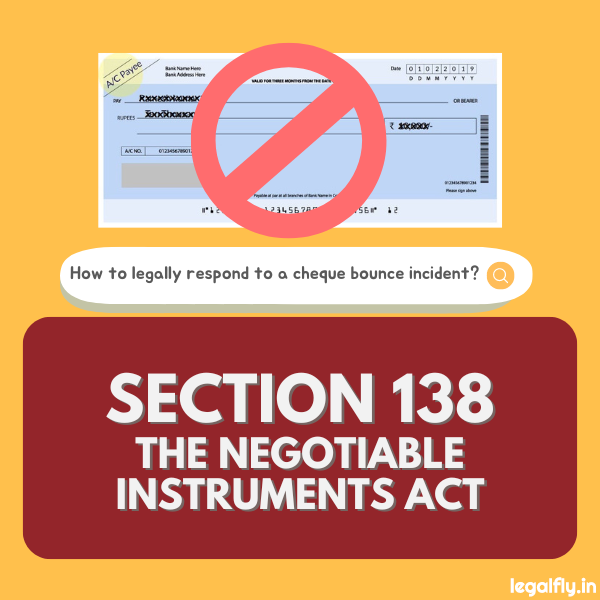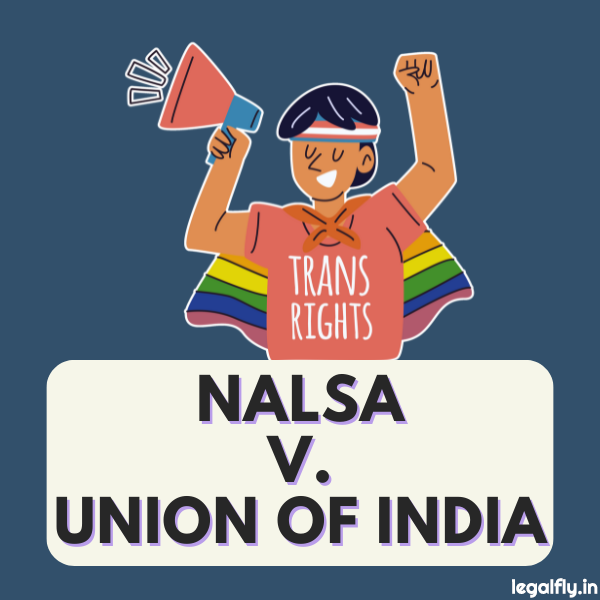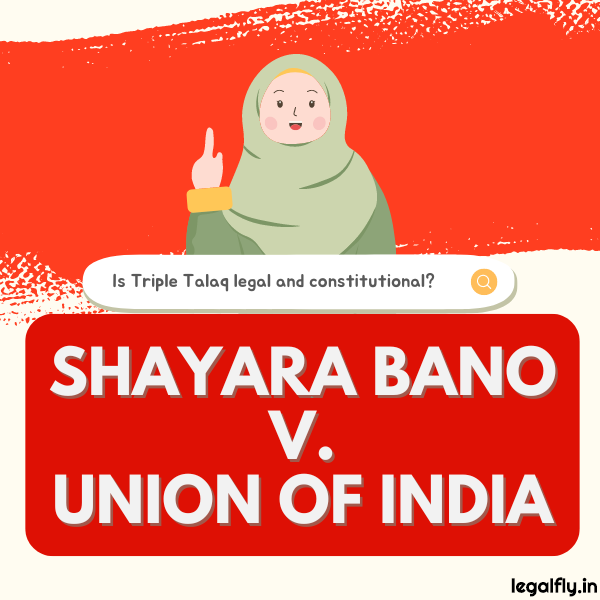Case Name: Harvey v. Facey Court: Judicial Committee of the Privy Council Year: 1893 Citation: [1893] UKPC 1, [1893] AC 552
Table of Contents
What is the significance of the Harvey v. Facey case in Contract Law?
Contract law is the set of rules that regulate the creation, interpretation, and enforcement of contracts between parties. There are some fundamental principles in contract law, including offer and acceptance, meeting of the minds, consideration, and intention to create legal relations. For a contract to be legally binding and enforceable, one party must make an offer, and the other party must accept it. Both parties must agree to the terms of the contract and intend to be bound by it. Most contracts require consideration, meaning something of value, such as money, must be exchanged. Understanding these essential elements of contract formation is crucial for anyone who deals with agreements, transactions, and business relationships.
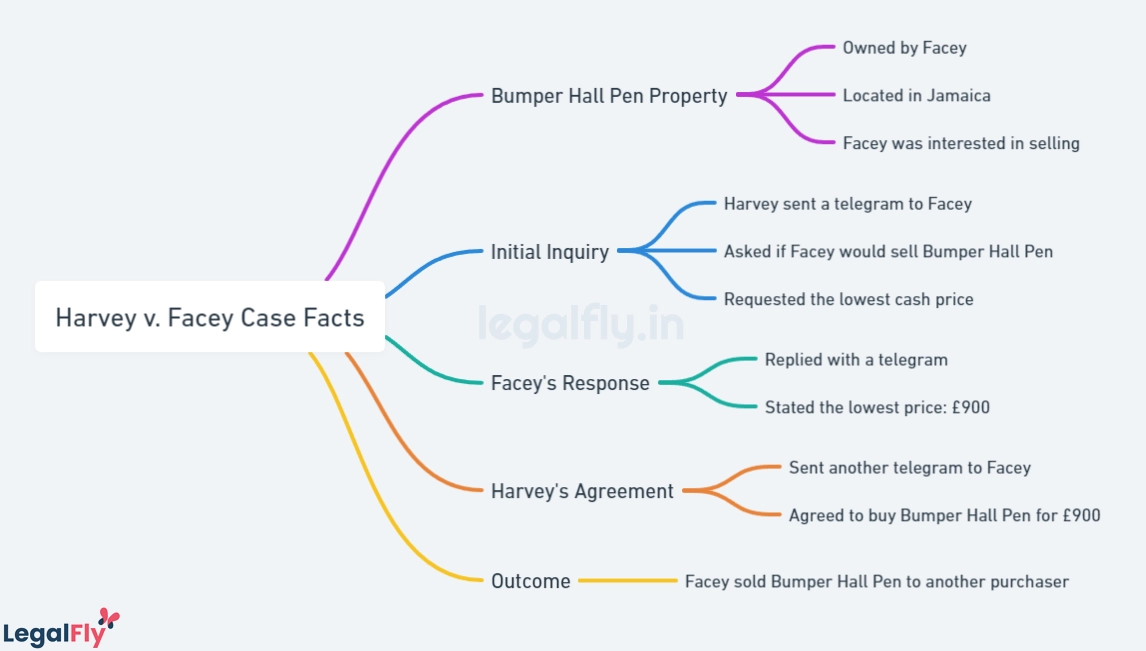
Harvey v. Facey Background
Harvey v. Facey [1893] UKPC 1 is a landmark decision in English contract law by the Privy Council, originating from an appeal against the Supreme Court of Jamaica’s ruling. The case proceedings began on November 17, 1892, with the final judgment delivered on April 7, 1893.
The key parties in the case were:
- Thomas Harvey – The appellant, who contended that a binding contract for the sale of a property had been established
- Horace Facey – The respondent who owned the property known as Bumper Hall Pen
The main facts of the case were:
- Facey owned a property called Bumper Hall Pen in Jamaica, which he was interested in selling
- Harvey sent a telegram to Facey inquiring, “Will you sell us Bumper Hall Pen? Telegraph lowest cash price.”
- Facey replied by a telegram stating, “Lowest price for Bumper Hall Pen £900.”
- Harvey then sent another telegram saying, “We agree to buy Bumper Hall Pen for the sum of £900 asked by you.”
- However, Facey had sold Bumper Hall Pen to another purchaser in the meantime
This set the stage for Harvey to sue Facey, alleging breach of contract. The core legal question was whether Facey’s telegram quoting the price constituted a valid offer that could be accepted or was merely an invitation to treat.
Facey’s Telegram
In Harvey v. Facey, the initial telegram that sparked the dispute was sent by Facey to Harvey. Facey’s telegram simply stated, “Lowest price for Bumper Hall Pen £900“. This was found to be an invitation to treat rather than an offer that could be accepted to form a binding contract.
The key reasons Facey’s telegram was an invitation to treat are:
- It did not demonstrate a clear, unequivocal intention to be bound by the terms in the telegram. Stating the price was not enough to constitute an offer capable of acceptance.
- No definite terms were provided, only a price quote, so it lacked specifics to constitute a valid offer.
- Merely providing a price in response to an inquiry about a property’s sale price is an invitation to treat per precedent.
- Additional negotiation was expected before a binding agreement could be reached. Facey’s telegram invited further discussion.
The court rightly held this was an invitation to treat as it lacked essential elements of an enforceable offer. Harvey could not unilaterally accept the invitation to treat as though it were an offer. This underscores the importance of correctly understanding the distinction between offers and invitations to treat.
Harvey’s Response
Harvey responded to Facey’s telegram by sending another telegram stating, “We agree to buy your Bumper Hall Pen property for the sum of £900 asked by you”. Harvey believed this telegram constituted a valid acceptance that formed a binding contract between the parties for the sale of the property.
Harvey thought Facey’s initial telegram quoting the price of £900 for the property was an offer that could be accepted. By stating “we agree to buy” at the price quoted, Harvey felt he was communicating acceptance and concluding the contract.
However, as the court’s decision later confirmed, merely quoting a price or value is not the same as making a clear offer capable of acceptance. Facey’s first telegram did not demonstrate intent to be legally bound or contained sufficiently detailed terms. As such, there was no offer for Harvey to accept. His telegram back was an offer that still required acceptance by Facey.
This distinction between offers and invitations to treat is a key principle established in this case. Harvey believed his telegram back formed a binding contract, but it was merely an offer requiring further acceptance since Facey’s initial message did not constitute a valid offer. The court upheld this interpretation.
Court’s Decision
The Privy Council held that no binding contract existed between Harvey and Facey. Facey’s initial telegram stating the price was not an offer that could be accepted to form a contract. Instead, it was merely an invitation to treat.
The court ruled that for a valid contract to exist, there must be a definite offer with the intention to be legally bound. Facey’s telegram did not constitute an offer according to contractual requirements. It was simply quoting a price in response to Harvey’s inquiry. This did not demonstrate an intent to enter into a binding agreement.
Since Facey’s telegram was an invitation to treat rather than an offer, Harvey’s subsequent reply purporting to accept the price did not create a contract. There was no offer that could be accepted. Hence, the court found no contractual relationship existed between the parties in this case.
Defining an Offer
One of the key principles established in Harvey v. Facey is the criteria that constitute a legally valid offer. For an offer to be considered valid and binding, it must meet several requirements as per contract law precedents:
- The offer must communicate a clear intention from the offeror to be legally bound by the terms of the offer if it is accepted. There should be certainty about the offeror’s intent.
- The offer must contain sufficiently definite terms to set out the nature and extent of contractual obligations clearly. Vagueness can invalidate an offer.
- The offer must be communicated and actually received by the offeree. Uncommunicated offers cannot be accepted.
- The offer must not indicate it is merely an invitation to treat or negotiation. Language suggesting a non-binding price quotation rather than a firm offer affects validity.
The case of Harvey v. Facey demonstrates these criteria. Facey’s initial telegram did not constitute a valid offer as it lacked the intention to be bound and used non-committal language about the price. For an offer to be valid and capable of acceptance, it must fulfill all the requirements per contract law principles established through precedents like this case.
Invitations to Treat
An “invitation to treat” refers to an action that invites other parties to make an offer rather than making an offer directly. It demonstrates a willingness to negotiate but is not legally binding. Some common examples of invitations to treat include advertisements, shop displays, and auctions.
The case of Harvey v. Facey established the difference between offers and invitations to treat. Merely quoting a price, as Facey did in his telegram, was deemed an invitation to treat rather than an offer that could be accepted. This precedent remains highly relevant today.
For instance, when a shop owner displays goods in their window, they are not making an offer to customers. Instead, it is an invitation for customers to come and make an offer to purchase those goods. The shopkeeper is free to reject offers and negotiate prices. Other examples of invitations to treat include advertisements of products or services, auctioneering, and catalog/website listings.
These examples show that an invitation to treat differs significantly from an offer. There is no intention to be legally bound by the invitation alone. Distinguishing between the two is vital in contract law to avoid one party mistakenly assuming an offer exists when it does not. Harvey v. Facey continues to be instrumental in elucidating this difference.
Case Impact
The case of Harvey v. Facey continues to be an important precedent in contract law for distinguishing between offers and invitations to treat. Though the case occurred over 100 years ago, the principles it established around what constitutes a valid offer remain highly relevant today.
When creating any contract in the modern era, parties must be careful to ensure there is a clear, definite offer with the certainty of terms that is adequately communicated and shows an intention to be legally bound. Simply providing information or a quotation of price is not enough – there must be an unequivocal offer capable of acceptance.
The case has provided enduring guidelines for businesses in how they present prices or communicate with customers. Displaying an item for sale in a shop window is considered an invitation to treat under Harvey v. Facey, not an offer that can be accepted. This allows businesses flexibility in whether they ultimately want to make a sale.
Professionals drafting contracts are also informed by this precedent in ensuring their contracts contain precise, definite offers and acceptances to be legally enforceable. Any ambiguity could render the agreement void, so principles from Harvey v. Facey remain indispensable.
By elucidating the difference between offers and invitations to treat, this case continues to shape how parties express intent to contract, make purchases, and seal agreements. The lessons for properly exchanging offers and acceptance are still highly applicable today.
Key Contract Principles
For a contract to be legally binding and enforceable, several key principles must be satisfied according to contract law. These essential elements are:
- Offer – One party must make an offer to another party that is clear, definite, and explicit in its terms. The offer must demonstrate the intent of the offeror to enter into a contract when accepted.
- Acceptance – The offeree must unconditionally accept the terms of the offer in entirety. Acceptance establishes both parties’ agreement to the contract terms and their intention to be legally bound.
- Intention – There must be an intention between the parties to create legal relations and a legally binding agreement. Offer and acceptance alone are insufficient.
- Communication – There must be proper and valid communication of the offer and acceptance between the parties. They must be aware of the contract specifics.
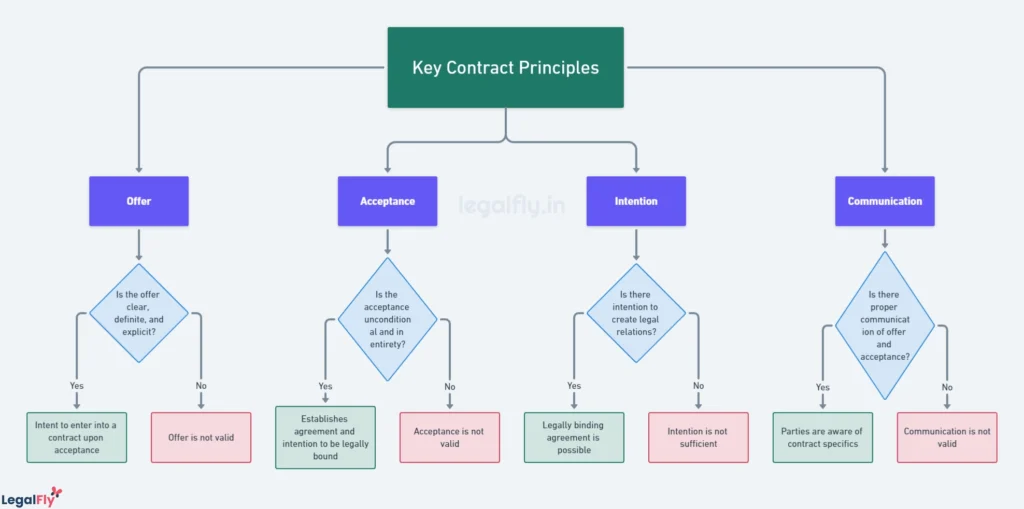
Harvey v. Facey highlights these fundamental principles of contract law. The case turned on the lack of a valid offer from Facey to Harvey. This precedent underscores the necessity of these essential elements for any legally enforceable contractual relationship. Understanding these key tenets can help parties avoid contractual disputes.
What were the main takeaways from the Harvey v. Facey case brief?
The landmark judgment of Harvey v. Facey helped make clear the rules about making and accepting offers that lead to contracts. It showed the difference between just asking if someone is interested in making a deal (which doesn’t have to lead to a contract) and making a real offer that, if accepted, creates a binding agreement. This distinction is still very important in understanding contracts today. Key learnings include:
- For an offer to be valid, it must demonstrate a clear intention to be legally bound and contain definite terms. Simply quoting a price or displaying goods is not sufficient.
- To create a binding contract, there must be proper offer and acceptance involving all essential elements like certainty of terms.
- The case demonstrated that Facey’s initial telegram was an invitation to treat, not a firm offer that could be accepted.
- The precedent that invitations to treat are not offers continues to apply in many common transactions today.
- The case elucidated fundamental principles of contract law, including offer, acceptance, consideration, and intention to create relations.

In summary, Harvey v. Facey established critical guidelines on contract formation that remain highly relevant. The key concepts clarify drafting agreements and help parties avoid contractual disputes resulting from misunderstandings. The learnings help legal professionals ensure binding contracts that withstand legal scrutiny.


